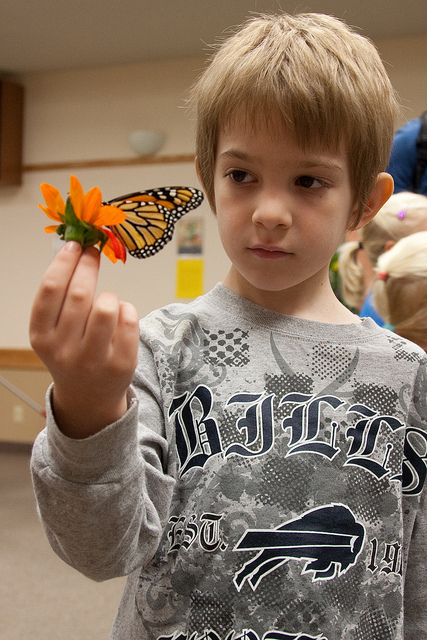For many, a connection with nature is made at a young age. Today, I can recall one of my first connections to the natural world. It was a third grade science lesson on Monarch Butterflies and pollination. My paradigm began to shift as I learned about the ecological importance of these beautiful insects. The days went on, and my curiosity flourished. My young brain desired an encounter with these intriguing creatures. In that same third grade classroom, we were going to raise Monarch caterpillars for the remaining weeks, ultimately nurturing them to butterfly adulthood. Eleven years later, I find myself walking the trails along the ponds here at Audubon longing for more frequent confrontations with these orange-and black-winged pollinators each day.

Boy experiencing a Monarch up close at Monarch Festival. By Jamestown Audubon.
While bees are typically known for their role as pollinators, Monarch Butterflies (Danaus plexippus) do their fair share. Butterflies like to settle on larger flower heads when they are searching for sweet nectar, collecting pollen on their legs and body as they collect food. The legs and the butterfly’s proboscis are longer and farther away from the flower’s pollen so less pollen collects on its body parts than it does on bees, but they are still very effective pollinators. Bees typically pollinate better, in that they fly in and out of flower heads, collecting the nectar on all parts of their bodies. Bee’s bodies are not as crane-like as butterflies, they have shorter legs and bodies. Butterflies typically pollinate during the day while flowers are open and they have a better color perception than bees or even humans. Monarchs have the ability to see their favorite color, red, while bees cannot. Along with bees, butterflies have the ecological advantage of being able to see ultraviolet light which makes finding nectar that much easier, making flower markings very distinct to them. Monarch butterflies preform a crucial role in our environment, but they are often under-valued. Butterflies can travel long distances, ensuring coverage of equal amounts of flowering plants in a larger area.
Every winter, Monarch butterflies flutter in a blizzard of orange-and-black to the Mexican mountain forests after a 2,800-mile trek through the United States and Canada. These butterflies execute a highly evolved migration, soaring from our backyards here in Western New York and Northwestern Pennsylvania to the mountain forests of Mexico, and then back again over the course of three generations. The size of this migration is more than a wondrous demonstration; it’s an ecological barometer. The more butterflies in Mexico, the healthier the Earth.
Monarchs, and other insects, are experiencing significant threats in terms of their existence. The populations of these pollinators are being reduced in alarming rates due to several environmental pressures. The butterflies’ winter habitat in Mexico is rapidly shrinking due to deforestation and urban development. Because all Monarchs gather in only a few locations for the winter, their overall population is at risk. Although monarchs feed on the nectar of many flowers, they lay their eggs only on milkweed plants. Unfortunately, milkweeds are often eradicated as weeds.
The Monarch is in trouble, but why is it critical that we do our part to assist? Because a world without Monarchs is tough to imagine. More than seventy-five percent of food crops rely at least in part on pollination by insects and certain bat species. Without these animals to pollinate, many of us would no longer be able to enjoy coffee, chocolate and apples, among many other foods that are part of our daily lives. A world without coffee and chocolate seems as uninviting as a world without Monarchs and other pollinators. I think back to my early connection to these amazing creatures and I cannot envision trekking around Western New York without spotting one.
To learn more about Monarch butterflies, please attend our annual Monarch Butterfly Festival Saturday, on Saturday, August 26, 2017 from 10:00 a.m. to 4:00 p.m. The Monarch Butterfly Festival features a room full of flying Monarchs where visitors can see and feed them while learning more about Monarchs. The Monarch Butterfly Festival has an adults only event the night before, Monarchs and Margaritas, which you can register for online at auduboncnc.org.
Audubon Community Nature Center builds and nurtures connections between people and nature. ACNC is located just east of Route 62 between Warren and Jamestown. The trails are open from dawn to dusk as is Liberty, the Bald Eagle. The Nature Center is open from 10 a.m. until 4:30 p.m. daily except Sunday when it opens at 1 p.m. More information can be found online at auduboncnc.org or by calling (716) 569-2345.


Recent Comments